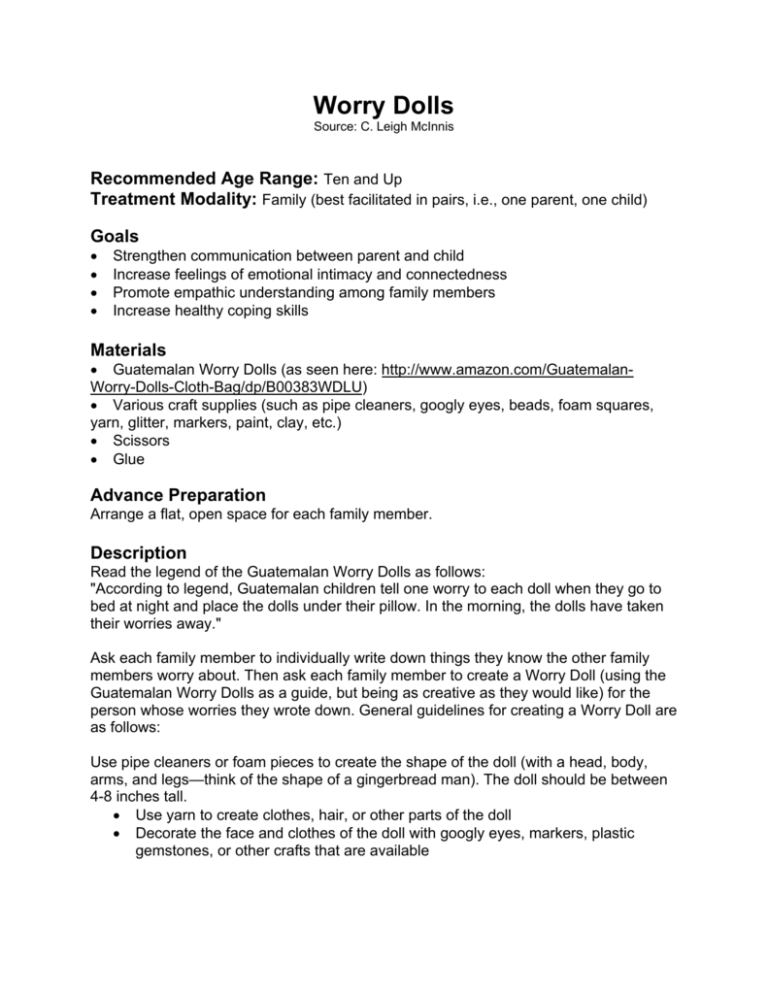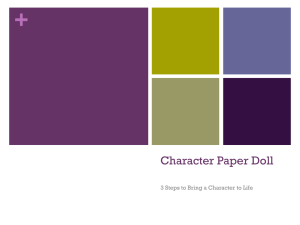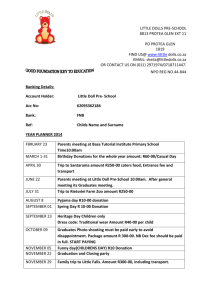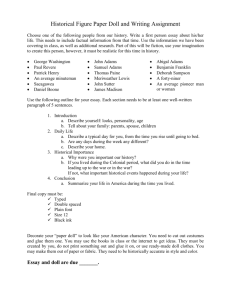
Worry Dolls
Source: C. Leigh McInnis
Recommended Age Range: Ten and Up
Treatment Modality: Family (best facilitated in pairs, i.e., one parent, one child)
Goals
•
•
•
•
Strengthen communication between parent and child
Increase feelings of emotional intimacy and connectedness
Promote empathic understanding among family members
Increase healthy coping skills
Materials
• Guatemalan Worry Dolls (as seen here: http://www.amazon.com/GuatemalanWorry-Dolls-Cloth-Bag/dp/B00383WDLU)
• Various craft supplies (such as pipe cleaners, googly eyes, beads, foam squares,
yarn, glitter, markers, paint, clay, etc.)
• Scissors
• Glue
Advance Preparation
Arrange a flat, open space for each family member.
Description
Read the legend of the Guatemalan Worry Dolls as follows:
"According to legend, Guatemalan children tell one worry to each doll when they go to
bed at night and place the dolls under their pillow. In the morning, the dolls have taken
their worries away."
Ask each family member to individually write down things they know the other family
members worry about. Then ask each family member to create a Worry Doll (using the
Guatemalan Worry Dolls as a guide, but being as creative as they would like) for the
person whose worries they wrote down. General guidelines for creating a Worry Doll are
as follows:
Use pipe cleaners or foam pieces to create the shape of the doll (with a head, body,
arms, and legs—think of the shape of a gingerbread man). The doll should be between
4-8 inches tall.
• Use yarn to create clothes, hair, or other parts of the doll
• Decorate the face and clothes of the doll with googly eyes, markers, plastic
gemstones, or other crafts that are available
While each member of the family creates a Worry Doll, write down things that more than
one person is worried about and create a Worry Doll for the pair/group. (For example,
as the family counselor you may know that both people are worried about finances, an
ailing family member, etc.)
Once everyone has created their Worry Dolls, have each family member present their
created doll to the person for whom they created it, and have them express which
worries the doll was made to help ease.
Then, present the Worry Doll that you created for the pair, pointing out the worries that
both members share.
Provide the family with an opportunity to discuss some of their worries, both the
individual and the shared ones. Encourage the family to work together to identify
strategies to reach out to each other for support and/or to alleviate some of the worries.
Facilitate discussion by asking the following process questions:
1.
2.
3.
4.
5.
6.
7.
What was it like to create a Worry Doll for your child/mother/father? Tell us
about the different components of the doll that you made.
Which worries were your child/mother/father accurate about? What are some
other worries (that they may have missed) that you would like to tell us about
today?
Are you surprised that your child/mother/father is aware that these are
significant worries for you? What do you think that you do to communicate
these worries to others?
According to the Guatemalan legend, the Worry Dolls are able to take away
children’s worries. How do you think that this is able to happen? Are there
people in your life that can help you with your worries?
How accurate was the list that I made of worries that you both share? Are
there worries that I missed? How does it make you feel to realize that you are
not alone in your worries?
Sometimes when people are worried about something, they struggle to
communicate their concern. What are some ways that other people can tell
that there’s something on your mind, even if you aren’t ready to talk about it?
(For example, you may get very quiet, listen to loud music, cry, etc.)
When you are worried about these (or other) things, what are some things
that your family members can do to help you?
Discussion
This activity encourages creativity and self-expression by incorporating doll-making into
the treatment process. The dolls made by the family members can take any form; the
presentation of the original “Worry Dolls” serves only as a prop to the introduction of the
activity. The dolls may reflect a client’s personality or they can incorporate images
related to the different worries.
This activity is best facilitated later in the treatment process, preferably after the
practitioner has worked with the family on effective communication skills and with each
participating member on addressing underlying emotional blocks and empathy. If
completed too early in the treatment process, it may not have the emotionally intimate
effect as intended.
Oftentimes, children feel as if their parents do not understand them (their struggles, their
emotions, etc.); simultaneously parents feel as if their children do not recognize
everything that they deal with (financially, emotionally, etc.) While it is not always
appropriate for parents to divulge all of their stressors to their children, (so as to avoid
‘parentifying’ them), it can be helpful for a parent to see that their child does empathize
with them.
The purpose of the practitioner making a doll to represent the family’s worries is to show
the family that they have similar concerns and shared, yet unspoken, worries. Through
follow-up processing, family “secrets” can be openly discussed and acknowledged
(when and if therapeutically appropriate). Once the family recognizes that they are not
alone in their worries, the practitioner can work with them to cope as a cohesive family
unit as opposed to each individual feeling burdened alone.
About The Author
C. Leigh McInnis, MA, NCC, QP, is a Regional Training Specialist and an intensive inhome counselor at the Institute for Family Centered Services in Winston-Salem, NC.
She works with families of at-risk youth with issues related to attachment, trauma,
substance abuse, and a variety of other emotional and behavioral symptoms. She has
also worked as a Crisis Counselor with adults with chronic mental health diagnoses.
She received her Master of Arts in Community Counseling at Marymount University in
Arlington, VA. She is currently certified in Family Centered Treatment and is pursuing
LPC credentials.
© 2012, C. Leigh McInnis. All rights reserved.








